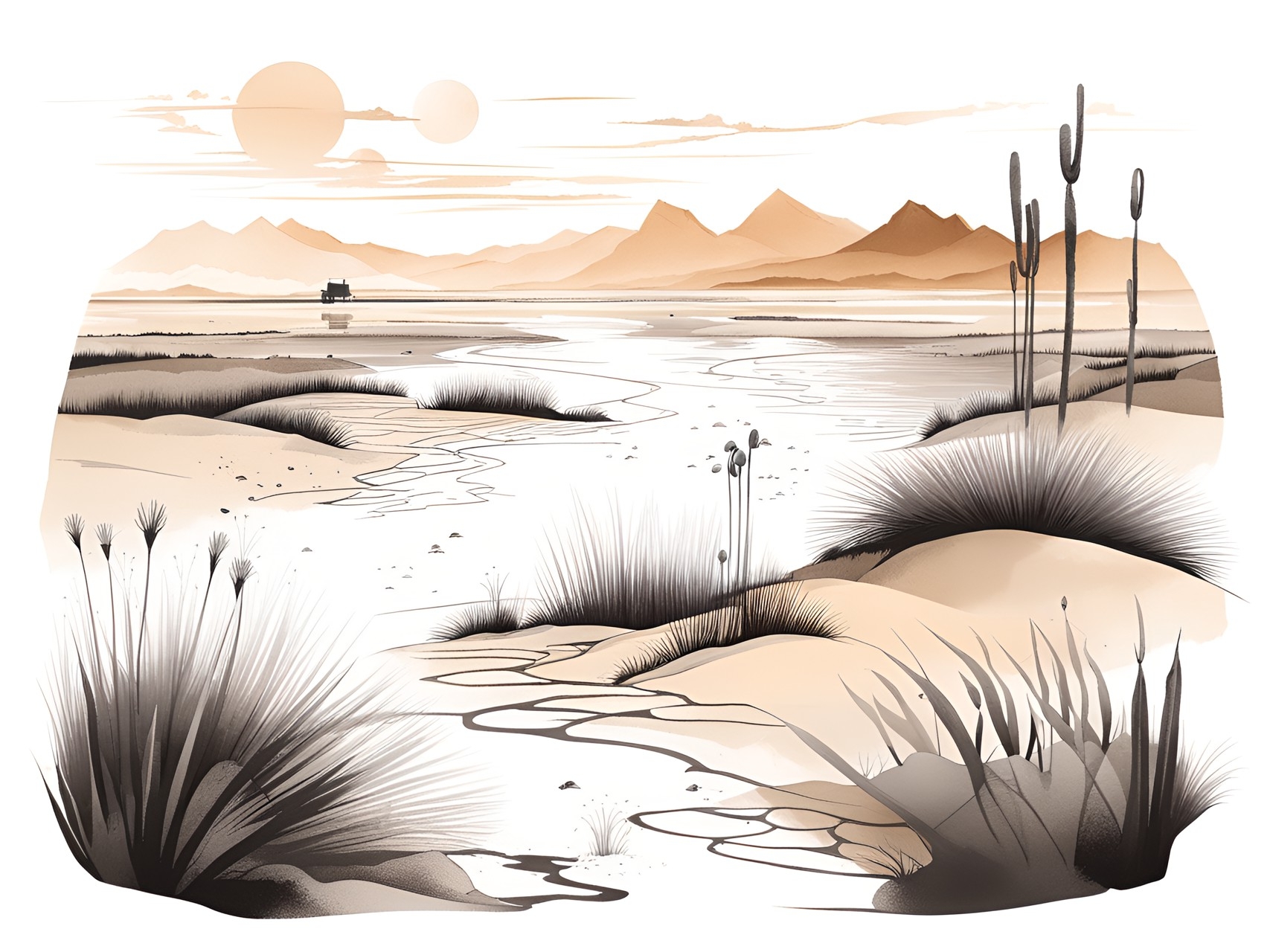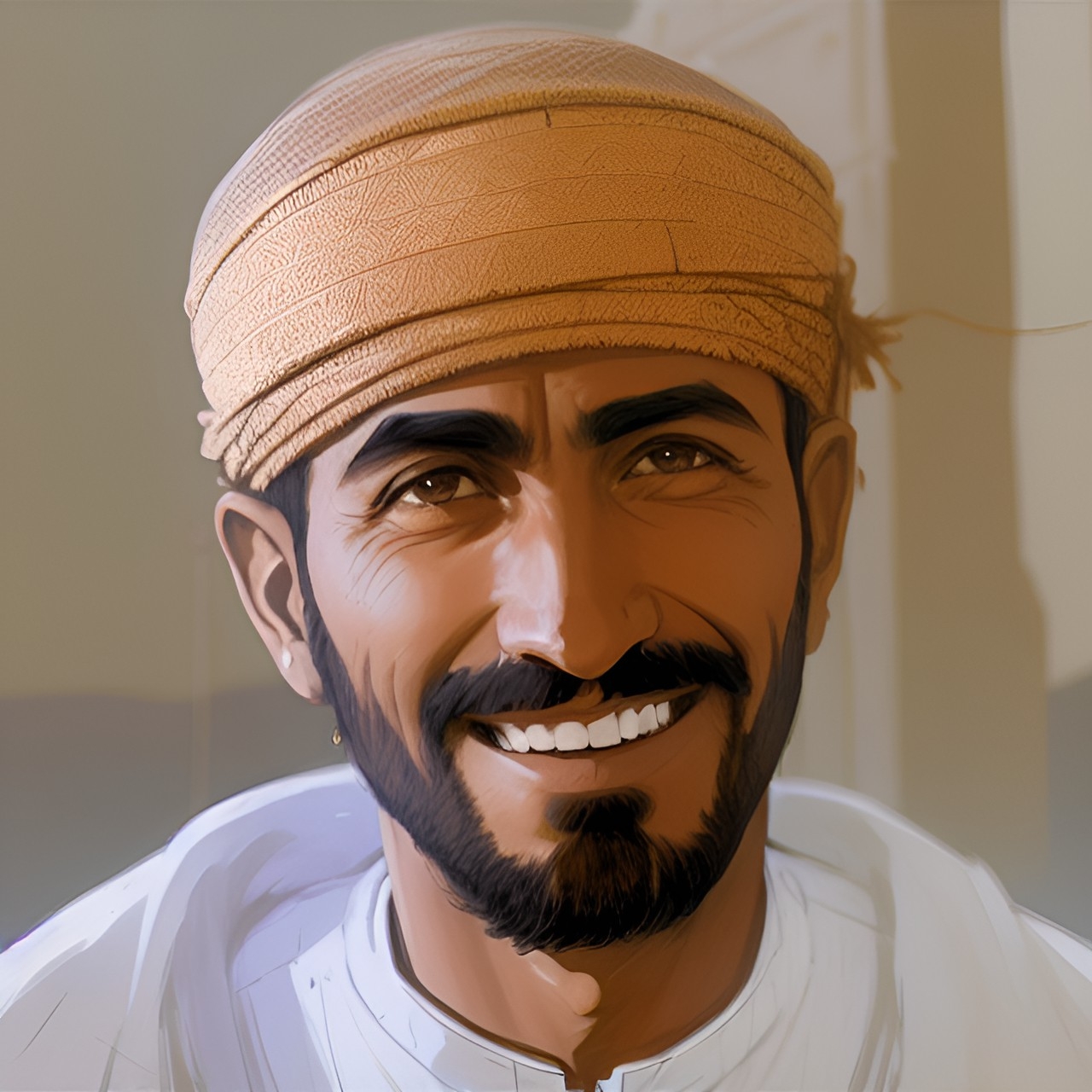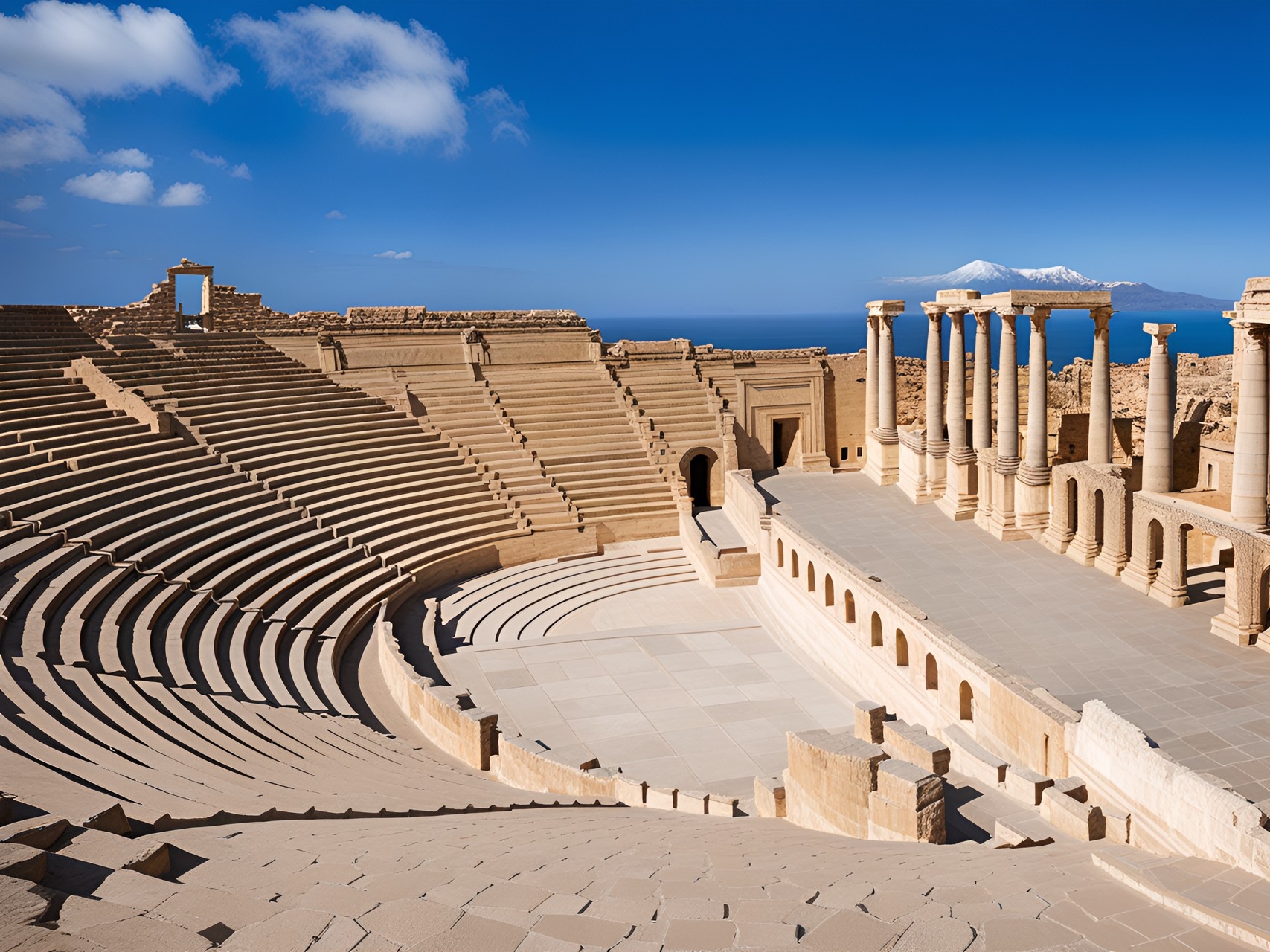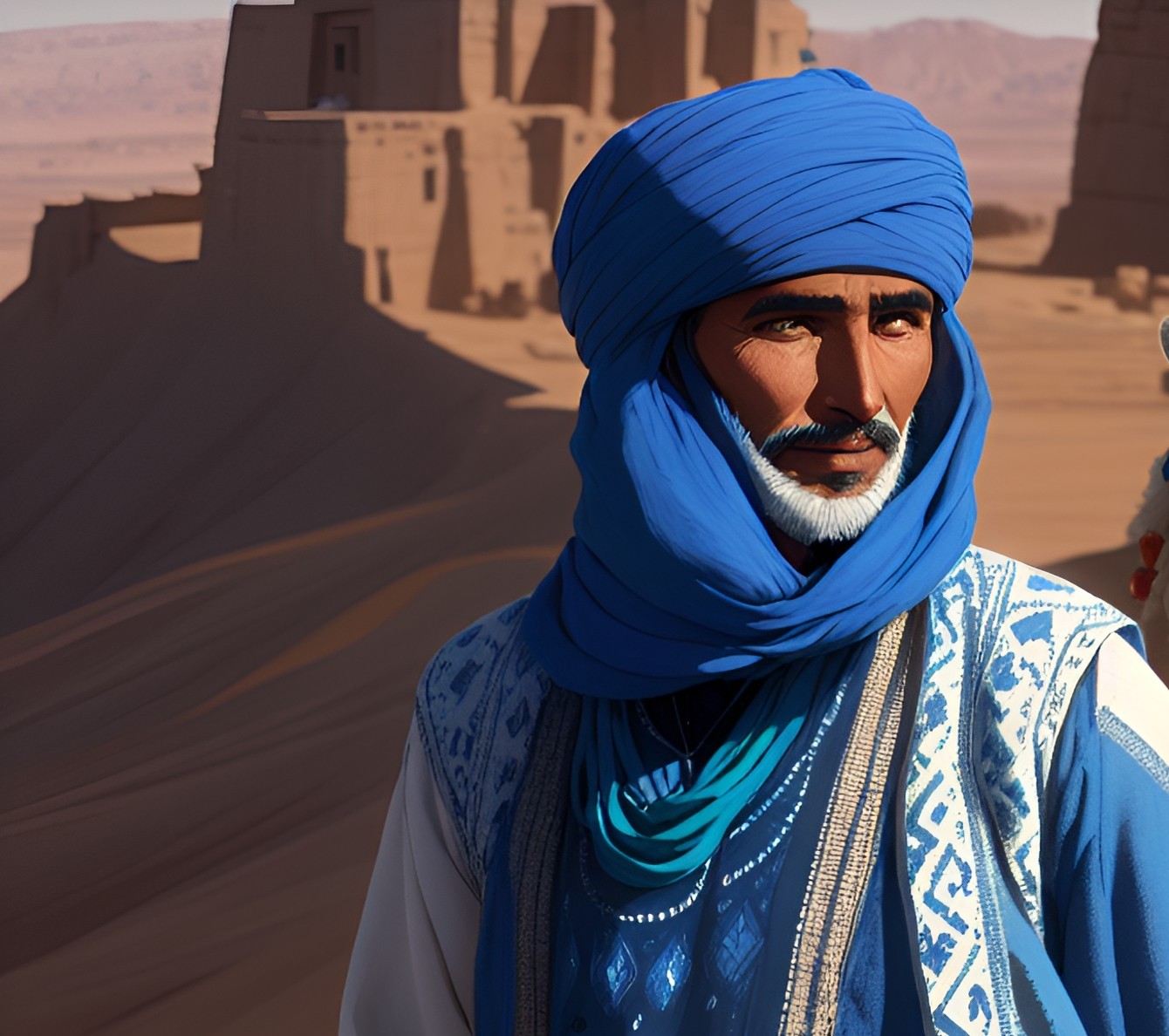Libu
The lands which make up Libu were once divided into many different civilizations. These fertile coasts have been sought after and consistently warred over throughout Emynean history. Coastal plains sprawl between the arctic Keyh Sea and the irradiated Idraren Draren mountains, separating most settlements from the sandy ergs of the Shamsi Desert. The three main provinces of Libu are Dzayir in the east, Tinis centrally and Tarablus in the west. Libu is almost entirely muslim, followers of Islam al'Rasul, and speak al-'arabiyyah. Only the stubborn nomadic Imaziɣen and Toubou have retained their original culture and religion.
Tarablus is adjacent to Dawn Ahrayn, Arya and Kemet, acting as the northwestern edge of the Shamsi Desert. Tarablus is home to the capital of Libu, Oyat. Largely barren, this region relies on their position as a center of trade and comerce to survive. Tinis is a far more fertile region despite being the smallest province, located centrally between Tarablus and Dzayir. Tinis was once home to a large empire originating from Put, Kna'an. They established a string of city-states with Tinis as their capital, named after their war goddess Tinnit. The fertile lands of Tinis are considered a breadbasket, reliably cultivating grains. Finally, Dzayir stretches along the eastern coasts of Alkelbulan and borders Marrakesh. The Imazighen population remains fairly high in Dzayir compared to Tinis and Tarablus, farther from the Arabiyy homelands and highly mountainous—home to the irradiated Idraren Draren.
Tarablus is adjacent to Dawn Ahrayn, Arya and Kemet, acting as the northwestern edge of the Shamsi Desert. Tarablus is home to the capital of Libu, Oyat. Largely barren, this region relies on their position as a center of trade and comerce to survive. Tinis is a far more fertile region despite being the smallest province, located centrally between Tarablus and Dzayir. Tinis was once home to a large empire originating from Put, Kna'an. They established a string of city-states with Tinis as their capital, named after their war goddess Tinnit. The fertile lands of Tinis are considered a breadbasket, reliably cultivating grains. Finally, Dzayir stretches along the eastern coasts of Alkelbulan and borders Marrakesh. The Imazighen population remains fairly high in Dzayir compared to Tinis and Tarablus, farther from the Arabiyy homelands and highly mountainous—home to the irradiated Idraren Draren.
Table of Contents
Location
Capital
Ruling Organizations
Official Languages
State Religion
Neighboring Countries
Geography
Population
Culture
Tarablus
Tinis
Dzayir
History
Tarablus
Tinis
Dzayir
Official Languages
State Religion
Neighboring Countries
Geography
Libu stretches across the entire northern coast of the Shamsi Desert and the Keyh Sea, consisting of two unique ecoregions. First is a narrow strip along the immediate coast which sees little to no rain, if any at all, yet it isn't totally dry. Thick fog forms over icy waters and wets the coast daily, sustaining a variety of lichens, succulents and shrublands. Delicate cacti from the Frozen Wastes possessing blessings from Iska grow alongside the luminous grasses of the Shamsi Desert such as Mashe Lovegrass or Jari Tamal. While the coast is bright and sunny for the bulk of the day, capable of reaching up to 122 F (50 C), the air becomes astonishingly humid during dawn and dusk. Temperatures plunge during the night thanks to the lack of cloud cover and the icy waters of Keyh. A variety of seabirds and Shamsi wildlife thrive along these fertile coasts. Further inland, there is another thin strip which is a transitionary zone between the coast and desert. These hills and highlands are still xeric but consist mainly of drought tolerant shrublands and light, temperate woodland. Summers are hot and bleakly arid while winters are cool and rainy, sometimes even snowing!
In western Libu, there is a very unique biome shared between Tarablus, Kemet and Arya which is called Qatarah. Qatarah formed within a significant depression lower than sea level, a drainage basin for a vast region. Qatarah is home to multiple oueds (dried lakebeds), chotts (dried salt lakebeds), sabkhas (salt flats) and salt marshes which flood seasonally. Outside of this inundation, the waters of Qatarah evaporate faster than they can resupply. Salt, and sometimes other minerals, are left behind as the water evaporates and creates thick layers of salt crystals over time, leaving any remaining water briney. While unseen, considerable radiation hides within these crystals and any remaining moisture, carried by the floodwaters and concentrated in rime. These barren flats can be deceptively dangerous, not every surface safe to tread over. Thin layers of salt can obscure deep muddy quagmires which swallow up the unwary in radioactive waters!
Salt tolerant plants from both Shamsi and Arya thrive in this environment, especially Maliha Tamarisk and reedgrass while the edges of these marshes are lined with Murna Acacia. Mammal life flourishes in Qatarah as well, including Giant Cheetah, Raqs Gazelle, Sahra Hare, Wata Jackal, Ayyur Fox, Azru Aoudad and Abu Qarn Oryx. Even the lands surrounding Qatarah thrive as scrublands, oases, palm groves and grasslands, Qatarah itself hugged by an erg sea in the south and the Diffa Plateau in the north—separated by steep cliffs reaching 920 ft!
The remainder of Tarablus is home to montane woodlands and xeric shrublands. Much like the rest of Shamsi, mountains are known to become more radioactive the further inland one travels while the immediate coast is usually safe. Tarablus is known for its harsh, dusty winds if not fullblown sandstorms while rain is extremely infrequent—some mountains not seeing a drop of rain for decades at a time! Most unforgiving is the heat which can reach up to 136 F (58 C)! Because of these harsh conditions, all inland settlements are centered around oases, wadis and wetlands. Meanwhile, Tinis has perhaps the coolest climate in Shamsi, its cape projecting into the Keyh Sea. Tinis receives more rainfall than anywhere else in Shamsi, this precipitation decreasing further inland. Low, rolling hills and plains stretch across Tinis' northern regions and are extremely fertile, popular for olive and grain cultivation. Finally, Dzayir is dominated by different branches of Idraren Draren, especially the Awrus and al-Tli ranges. The depths of these mountains contain vast, irradiated highland plains which are home to tribes of Toubou and Imaziɣen nomadic pastorialists. Rain is infrequent, obstructed by hot desert thermals and the jagged mountain peaks. While the coast is lush and fertile, everything beyond these mountains is hyperarid.
Population
Living almost exclusively along the coasts, and mountains, most citizens of Libu are Arabiyy, Imaziɣen or a mix of the two. Smaller, nomadic populations are also present, some more prevalent in one region over another. In fact, as the populaton of Arabiyy and Eluzian peoples grow in Libu the nomadic Imazighen shrink, either forced to settle down into sedentary life or executed for their resistance to Accian rule.
Culture
Tarablus
While most of the population is Arabiyy and Imazighen, Tarablus still carries cultural marks of their various occupations. Whether these are ancient architecture and mosaics left behind by the Quiris-Hellenes empire or hybrid cuisine involving Italiani traditions, these influences are pervasive. Food staples of Libu include Azeradj Olives, Khisbat Palm dates, grains and milk. Pasta and rice have become an everyday food in Tarablus. Dishes can include tomato based pasta dishes, rice with lamb or chicken and couscous, steamed over tomato sauces and meat. Vegetables like cucumber, lettuce, olives, zucchini and chickpease are commonly included too. A communal dish shared between several people, a dish called bazeen, is made from barley flour and tomato sauce, mostly presented during weddings and festivals. Asida is a sweeter version of bazeen which is made instead from white flour with honey, ghee or butter. Alternately, it can be served with Khisbat Palm date syrup and Azeradj Olive Tree olive oil. Finally, usban is made from tripe (animal stomach) stuffed with rice and vegetables before being cooked in tomato soup. After eating, it is common to drink black tea and snack on roasted peanuts or almonds.
Tinis
Theater is popular in Tinis, an artform actually endorsed by and enjoyed by Ilnid himself. They make use of the many Quiris structures left behind. Painting is another appreciated artform in Tinis, especially the painting of glass. Festivals occur in Tinisian towns in the summer. These festivals are enlivened by musicians, artists, tourists and even horse races. The city Susa is known for its festival in July which hosts a parade of chariots, fanfare and folk music in order to celebrate the passing of the hottest month of the year. Another festival is Omek Tannou, a rainmaking festival celebrating Tannit, only celebrated in isolated Imazighen villages which still worship her.
Dzayir
Dzayir cities are rich in music, art and cuisine. A few popular styles of music come from various influences throughout their history. These include the Chaabi music featuring Arabic poetry called Qacidate. Folk music of the Siryan people also involves the use of poetry called kacida while Imazighen music has both poetry and old tales integrated into their songs which are passed down orally through generations. In fact there are different styles of this folk music among the different tribes of Idraren Draren. In regards to food, couscous is the most common dish in Dzayir. Cereals are usually the focus of dishes, rarely absent from any cuisine. Vegetables vary the most between regions and season. Dishes include chorba (stew), rechta (long pasta strips), chakhchoukha (rolled semolina dough and tomato stew), berkoukes (giant couscous tomoto stew), shakshouka (eggs poached in vegetable stew), mthewem (meatballs and sauce), chtitha (chicken and chickpeas), dolma (stuffed vegetables), brik (stuffed and fried pastry), garantita (baked chickpea and egg batter), lham'hlou (meat with fruit and nuts in syrup). There are actually a wide variety of sweets and cakes in Dzayir as well and street food is popular in their markets.
History
Tarablus
The first inhabitants of Tarablus, and in all of Libu, were the Imaziɣen. But as this region is highly valued for its ports and defensible posiiton, the original settlement was quickly overtaken by invaders from Put, Kna'an called the Kna'ani. These invaders established several city-state throughout the coast of the Keyh Sea, based in the city of Tinis further east, subsequently losing these to the Quiris-Hellenes empire. Tarablus reached its golden age under the longheld administration of the Arabiyy, ruled by a Caliph installed by Ilnid. The lands of Tarablus have even fallen under the rule of Masryeen pharaohs in the past.
The most recent battles over Tarablus were fought between these caliphates and the Kingdom of Accia over the course of the last two hundred years. The first wave of Accian invaders were led by the Espina House but the city was lost again thanks to Turkler turncoats. Imazighen pirates controlled the coasts of Libu for some time, cooperating with the Pasha (Caliph) of Oyat until finally falling to the kingdom for a final time. Since this last battle, Oyat has been managed by Italiani aristocrats of the Espina House and Quiris nobility of the Aquila House, finally forcing Ilnid to delegate with the kingdom now so close to Kemet. This administration has been extremely prejudiced against the nomadic populations of Imazighen, who are the indiginous peoples of Shamsi, going so far as to lay claim to the lawless lands of Aznag and erdicating non-compliant nomads at every turn.
The most recent battles over Tarablus were fought between these caliphates and the Kingdom of Accia over the course of the last two hundred years. The first wave of Accian invaders were led by the Espina House but the city was lost again thanks to Turkler turncoats. Imazighen pirates controlled the coasts of Libu for some time, cooperating with the Pasha (Caliph) of Oyat until finally falling to the kingdom for a final time. Since this last battle, Oyat has been managed by Italiani aristocrats of the Espina House and Quiris nobility of the Aquila House, finally forcing Ilnid to delegate with the kingdom now so close to Kemet. This administration has been extremely prejudiced against the nomadic populations of Imazighen, who are the indiginous peoples of Shamsi, going so far as to lay claim to the lawless lands of Aznag and erdicating non-compliant nomads at every turn.
Tinis
The space between the mountains and sea of Tinis are very fertile, farmed extensively for grains which has made Tinis desireable throughout Alkelbulian history. While the Imaziɣen are indiginous to Tinis, the first recorded empire in Tinis was that of the Kna'ani based in th city of Tinis. These invaders originated from a city-state in Kna'an called Put, known in Kna'an as the Ponnim people. This empire had no official name as the tradition of the Kna'ani was to use their home city as their endonym. Tinis was named in honor of their war goddess, Tinnit. A slew of cities along the coast of all of Libu rose under their rule, a mix between ports and merchant towns. The Kna'ani didn't often delve into the mountains or desert but local Imazighen were either abducted and enslaved or forced to pay tribute to Kna'ani leaders.
Eventually, the Kna'ani empire fell to the Quiris-Hellenes empire venerating the Erlithmanil. This empire held onto Tinis for centuries, leaving behind many a monument such as amphitheaters and colloseums. Local Imazhighen were called Numidea by the Quiris meaning nomad, much of the mountains belonging to them throuhout their reign. However, with the Downfall of the Erlithmanil this empire fell alongside them, opening the door for Arabiyy invaders to spread across Alkelbulan in their absence. Over the course of many centuries, wave after wave of Arabiyy migrants flooded northern Alkelbulan and overtook the Imazighen as the main population. It had remained under Arabiyyan control despite being a frequent naval target for the Kingdom of Accia. But now that Ilnid has signed a treaty with the Kingdom, allowing international trade between their cities, Tinis is left in a nervous but hopeful economic boom.
Eventually, the Kna'ani empire fell to the Quiris-Hellenes empire venerating the Erlithmanil. This empire held onto Tinis for centuries, leaving behind many a monument such as amphitheaters and colloseums. Local Imazhighen were called Numidea by the Quiris meaning nomad, much of the mountains belonging to them throuhout their reign. However, with the Downfall of the Erlithmanil this empire fell alongside them, opening the door for Arabiyy invaders to spread across Alkelbulan in their absence. Over the course of many centuries, wave after wave of Arabiyy migrants flooded northern Alkelbulan and overtook the Imazighen as the main population. It had remained under Arabiyyan control despite being a frequent naval target for the Kingdom of Accia. But now that Ilnid has signed a treaty with the Kingdom, allowing international trade between their cities, Tinis is left in a nervous but hopeful economic boom.
Dzayir
Much like Tarablus, Dzayir has been home to many an outside occupation. When the Kna'ani empire fell to the Quiris, this period was followed by multiple Imaziɣen empires throughout Dzayir history. Subsequent invasions include the Quiris, Quiris-Hellenes and the Arabiyy. Most of Dzayir remained in Imazighen control, even amid massive Arabiyy migrations. This held true until their most recent invasion, that of the Kingdom of Accia. These invaders were at first Espanol and Francais, eventually annexing Dzayir as a territory of the kingdom and falling under the rule of the Chevalier House of the Ten Houses.
Back when the city of Tinis was destroyed by Quiris invaders and the Kna'ani empire fragmented, Imazighen tribes from the mountains descended into Dzayir and took over the remaining Kna'ani cities. Some of these port towns remained under the control of the remaining Kna'ani but the interior and majority of Dzayir was Imazighen. Another empire rose from these victories, split between two opposing federations of Imazighen, Massylii and Masaesyli. The Quiris-Hellenes empire collectively called them the Numidae Kingdom. While the Quiris eventually conquered the coasts of the Keyh Sea for themselves, they lacked the Racial Magic to penetrate the depths of Idraren Draren.
The Quiris-Hellenes empire retained control of the costs of Libu, which they called Mauri, until their collapse after the Downfall of the Erlithmanil, building numerous cities. Grains, dates and artisan goods from Kasar Wuta were transported through Shamsi routes before setting sail from Dzayir ports. As this empire fell apart, Libu was again briefly in control of local Imazighen who had again remained politically independant in their irradiated highlands. Far more pervasive was the invasion of the Arabiyy, guided by Ilnid and his Caliphates. This invasion impacted the way of life in Libu primarily thanks to the persistant conversion of Imazighen to Islam al'Rasul. However, unlike most other Arabiyyan territories, the conversion of the Imazihen in Dzayir was not as complete as it had been elsewhere. Both the Imazighen and the Toubou further south proved more stubborn and independant, especially nomadic tribes, hanging onto traditional beliefs in the bossom of Idraren Draren.
A stable Caliphate was established across many city-states of Libu for centuries, stretching all the way the Arabiyyan Desert. There is even a popular legend of a hero challenging and dueling various political rivals in Dzayir, an epic by the name of al-Taghribat. While there was infighting between Arabiyy rulers and factions, Ilnid retained overall control over Libu. Yet despite their influence, Imazighen tribes of the mountains remained independant and resistant. There were times in which tribes would attempt to drive out the Arabiyy, who were more likely to attack and destroy their desert settlements, but they would always return with fresh numbers. Some Imazighen turned to piracy during this era while other communities became more reclusive and insulative. Sea warfare was amid the earliest sieges of Alkelbulian cities by the Kingdom of Accia, led primarily by Espanol and Hellenes captains. It wasn't uncommon for these pirates to take non-muslim captives as slaves if not selling them to Ilnid's Caliphates, a practice which quickly drew the ire of the kingdom. Amid the worst of this, they would even invade the Eluzian coast of the Keyh Sea to capture slaves. Eventually, this led the kingdom to enact indiscriminate bombardments of the coast of Libu using both cannons and magic. These coastal cities now fall back on the aid of their attackers to recover from this tumultuous, wrathful assault.
Back when the city of Tinis was destroyed by Quiris invaders and the Kna'ani empire fragmented, Imazighen tribes from the mountains descended into Dzayir and took over the remaining Kna'ani cities. Some of these port towns remained under the control of the remaining Kna'ani but the interior and majority of Dzayir was Imazighen. Another empire rose from these victories, split between two opposing federations of Imazighen, Massylii and Masaesyli. The Quiris-Hellenes empire collectively called them the Numidae Kingdom. While the Quiris eventually conquered the coasts of the Keyh Sea for themselves, they lacked the Racial Magic to penetrate the depths of Idraren Draren.
The Quiris-Hellenes empire retained control of the costs of Libu, which they called Mauri, until their collapse after the Downfall of the Erlithmanil, building numerous cities. Grains, dates and artisan goods from Kasar Wuta were transported through Shamsi routes before setting sail from Dzayir ports. As this empire fell apart, Libu was again briefly in control of local Imazighen who had again remained politically independant in their irradiated highlands. Far more pervasive was the invasion of the Arabiyy, guided by Ilnid and his Caliphates. This invasion impacted the way of life in Libu primarily thanks to the persistant conversion of Imazighen to Islam al'Rasul. However, unlike most other Arabiyyan territories, the conversion of the Imazihen in Dzayir was not as complete as it had been elsewhere. Both the Imazighen and the Toubou further south proved more stubborn and independant, especially nomadic tribes, hanging onto traditional beliefs in the bossom of Idraren Draren.
A stable Caliphate was established across many city-states of Libu for centuries, stretching all the way the Arabiyyan Desert. There is even a popular legend of a hero challenging and dueling various political rivals in Dzayir, an epic by the name of al-Taghribat. While there was infighting between Arabiyy rulers and factions, Ilnid retained overall control over Libu. Yet despite their influence, Imazighen tribes of the mountains remained independant and resistant. There were times in which tribes would attempt to drive out the Arabiyy, who were more likely to attack and destroy their desert settlements, but they would always return with fresh numbers. Some Imazighen turned to piracy during this era while other communities became more reclusive and insulative. Sea warfare was amid the earliest sieges of Alkelbulian cities by the Kingdom of Accia, led primarily by Espanol and Hellenes captains. It wasn't uncommon for these pirates to take non-muslim captives as slaves if not selling them to Ilnid's Caliphates, a practice which quickly drew the ire of the kingdom. Amid the worst of this, they would even invade the Eluzian coast of the Keyh Sea to capture slaves. Eventually, this led the kingdom to enact indiscriminate bombardments of the coast of Libu using both cannons and magic. These coastal cities now fall back on the aid of their attackers to recover from this tumultuous, wrathful assault.


















Comments